Just released from the City of Portland are impressive stats for daily bike traffic over the four main Portland bridges. These stats are from this summer and they reflect the largest jump in bike traffic since records started being kept back in 1992 and how a nearly 15% jump since last year alone.
The bridges surveyed are the:
- Hawthorne
- Steel
- Broadway
- Burnside
Here’s a quick comparison:
- 1992 – 2,855 total bike trips
- 2004 – 8,875 total bike trips
- 2005 – 10,192 total bike trips
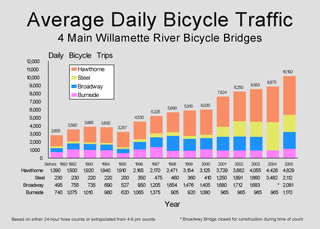
Congratulations to everyone that helps make Portland a great place to ride a bike. These numbers are the fruit of your efforts! If you like charts and graphs, I’ve posted a few others on my Bike Safety page.


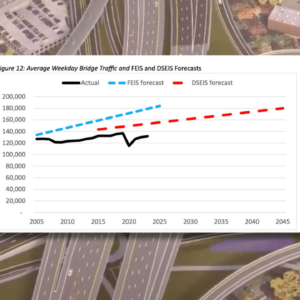
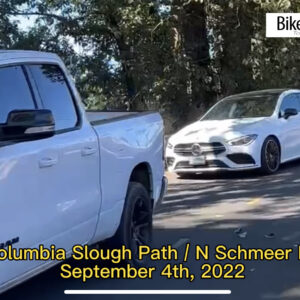
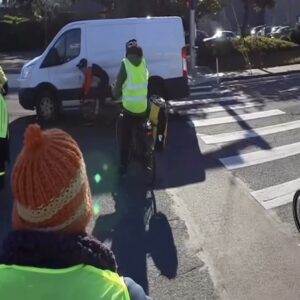
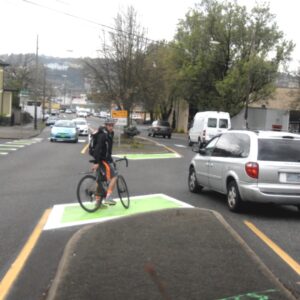
Thanks for reading.
BikePortland has served this community with independent community journalism since 2005. We rely on subscriptions from readers like you to survive. Your financial support is vital in keeping this valuable resource alive and well.
Please subscribe today to strengthen and expand our work.
Wow! I am not surprised. Bikes (and walking) are great alternatives to piloting motor vehicles. I have been bike commuting for over 25 years and the past couple years there has been a very noticable increase in bike traffic at all hours.
Please!!! Both experienced and new commuters, LIGHT UP your bikes! Morning commutes are now in the dark or sunrise. Poorly lit bikes are very close to invisible to motorists AND to other bikes and pedestrians. When the rainy weather begins bikes will be truly invisible to many motorists who are also distracted by wipers, foggy windows, and control of their vehicles.
Don’t become a news item! Get LIT like your life depended on it.
Wow! I am not surprised. Bikes (and walking) are great alternatives to piloting motor vehicles. I have been bike commuting for over 25 years and the past couple years there has been a very noticable increase in bike traffic at all hours.
Please!!! Both experienced and new commuters, LIGHT UP your bikes! Morning commutes are now in the dark or sunrise. Poorly lit bikes are very close to invisible to motorists AND to other bikes and pedestrians. When the rainy weather begins bikes will be truly invisible to many motorists who are also distracted by wipers, foggy windows, and control of their vehicles.
Don’t become a news item! Get LIT like your life depended on it.
I’m thrilled to see we’ve broken the 10,000 cyclist mark! How long will it take to get the next 10,000 Portlanders biking? Let’s all see if we can do it in less than a decade.
Someone once observed that cyclists are different than drivers because if you told a driver that tomorrow there would be twice as many cars on the road, they’d have a fit, but if you told a cyclist that there would be twice as many bikes on the road tomorrow, they’d throw a big party. Here’s to the bike party!
This is great but it leaves out those of us who ride to downtown from the westside. It feels to me that more people are riding in from my side of town as well.
I’m thrilled to see we’ve broken the 10,000 cyclist mark! How long will it take to get the next 10,000 Portlanders biking? Let’s all see if we can do it in less than a decade.
Someone once observed that cyclists are different than drivers because if you told a driver that tomorrow there would be twice as many cars on the road, they’d have a fit, but if you told a cyclist that there would be twice as many bikes on the road tomorrow, they’d throw a big party. Here’s to the bike party!
The stats are great, but they also don’t include those of us who both live and work on the East side, Lloyd area in particular.
The chart of bicycle traffic is great, and it leads me to a few questions.
It’s interesting to note that the 2003 combined total for the Steel and Broadway bridges was only 61 riders less than the 2004 count for the Steel Bridge alone (while the Broadway Bridge was not monitored). Did bicyclists make the switch that readily, or did the city create an estimate by adding the 2003 Broadway total to the 2004 Steel Bridge riders actually counted?
In either case, it looks to me like the Broadway Bridge construction suppressed the totals for 2004, thereby inflating the ratio between 2005 and 2004. But it’s still very encouraging to see that over 10,000 bicycling trips were made across these four bridges this summer.
I’m also wondering how the recent increase in bicycle traffic compares with the general rise in Portland’s population. Does anyone know?
This is great but it leaves out those of us who ride to downtown from the westside. It feels to me that more people are riding in from my side of town as well.
This site is such a great resource for getting the word out about things like this. Thanks Jonathan.
The counts we do on the 4 main bicycle-friendly Willamette R bridges clearly account for only a fraction (albeit, a pretty healthy fraction) of the bicycling activity going on around town. As contributors to this site–and many other–have noted, these counts do not capture trips from SW or NW Portland, or trips that don’t start or end on one side of the river.
We’re not trying to say that these counts are anything more than they are: which is a snapshot of cycling activity between Downtown and points east. We, in Portland’s Office of Transportation, simply look at these counts as an indication of overall cycling activity in Portland, or at least in the Central City. We use these bridges because they have a funneling affect on cycling activity and are thus are 4 reliable locations where we can capture a very high proportion of trips across the river.
There are clearly many more than 10,000+ bicycle trips in Portland. We focus on these bridge counts because they provide us the most reliable, long-term data showing trends in bicycle trips. Our assumption is that as go the bridges so goes much of the rest of Portland (or at least the inner parts). So, those of you in the Lloyd District and elsewhere, please don’t feel left out. Unfortunately we just don’t have the resources to conduct annual comprehensive counts everywhere in the City. You’re in our hearts and minds, if not yet reflected in our numbers.
Roger Geller
P.S. The Broadway Bridge no-count in 2004 was a result of our counts being conducted at a time when the Broadway Bridge was closed to all traffic. We assumed that cyclists would simply find other ways to cross the river, which they apparently did, as reflected in the much larger than normal counts for the Steel Bridge.
RG
How are bridge crossings counted? In particular, does a “daily bicycle trip” mean one river crossing or two (there and back)?
I’m trying to get some idea of what fraction of Portland’s population is crossing the four main Willamette River bridges. So I would first like to know more about what the 10,192 snapshot actually represents. Do you have more answers, Roger? Thanks for your help.
Mark Knapp
The stats are great, but they also don’t include those of us who both live and work on the East side, Lloyd area in particular.
The counts on the Broadway, Hawthorne, and the Steel are 24-hour counts taken by pneumatic counters on the bridge paths. The counts on the Burnside are 2-hour, peak hour counts (4-6 pm) which are then extrapolated to a full-day count using the (standard traffic counting) assumption that the 2-hour peak represents 20% of all daily traffic.
The counts represent “trips.” A trip is anytime a person goes from one place to another, so a “daily bicycle trip” is one river crossing.
Roger Geller
Having done bike counts on both sides of the river for 2004, I can attest to the fact that there are more cyclists than this number indicates. I know that there are many commuters who do not need to cross the Wilamette River, myself included. It would be difficult to refine these numbers as a part of the whole accounting but it should be noted that the number of cyclists who cross the Wilamette River outnumber those who don’t.
The chart of bicycle traffic is great, and it leads me to a few questions.
It’s interesting to note that the 2003 combined total for the Steel and Broadway bridges was only 61 riders less than the 2004 count for the Steel Bridge alone (while the Broadway Bridge was not monitored). Did bicyclists make the switch that readily, or did the city create an estimate by adding the 2003 Broadway total to the 2004 Steel Bridge riders actually counted?
In either case, it looks to me like the Broadway Bridge construction suppressed the totals for 2004, thereby inflating the ratio between 2005 and 2004. But it’s still very encouraging to see that over 10,000 bicycling trips were made across these four bridges this summer.
I’m also wondering how the recent increase in bicycle traffic compares with the general rise in Portland’s population. Does anyone know?
This site is such a great resource for getting the word out about things like this. Thanks Jonathan.
The counts we do on the 4 main bicycle-friendly Willamette R bridges clearly account for only a fraction (albeit, a pretty healthy fraction) of the bicycling activity going on around town. As contributors to this site–and many other–have noted, these counts do not capture trips from SW or NW Portland, or trips that don’t start or end on one side of the river.
We’re not trying to say that these counts are anything more than they are: which is a snapshot of cycling activity between Downtown and points east. We, in Portland’s Office of Transportation, simply look at these counts as an indication of overall cycling activity in Portland, or at least in the Central City. We use these bridges because they have a funneling affect on cycling activity and are thus are 4 reliable locations where we can capture a very high proportion of trips across the river.
There are clearly many more than 10,000+ bicycle trips in Portland. We focus on these bridge counts because they provide us the most reliable, long-term data showing trends in bicycle trips. Our assumption is that as go the bridges so goes much of the rest of Portland (or at least the inner parts). So, those of you in the Lloyd District and elsewhere, please don’t feel left out. Unfortunately we just don’t have the resources to conduct annual comprehensive counts everywhere in the City. You’re in our hearts and minds, if not yet reflected in our numbers.
Roger Geller
P.S. The Broadway Bridge no-count in 2004 was a result of our counts being conducted at a time when the Broadway Bridge was closed to all traffic. We assumed that cyclists would simply find other ways to cross the river, which they apparently did, as reflected in the much larger than normal counts for the Steel Bridge.
RG
How are bridge crossings counted? In particular, does a “daily bicycle trip” mean one river crossing or two (there and back)?
I’m trying to get some idea of what fraction of Portland’s population is crossing the four main Willamette River bridges. So I would first like to know more about what the 10,192 snapshot actually represents. Do you have more answers, Roger? Thanks for your help.
Mark Knapp
The counts on the Broadway, Hawthorne, and the Steel are 24-hour counts taken by pneumatic counters on the bridge paths. The counts on the Burnside are 2-hour, peak hour counts (4-6 pm) which are then extrapolated to a full-day count using the (standard traffic counting) assumption that the 2-hour peak represents 20% of all daily traffic.
The counts represent “trips.” A trip is anytime a person goes from one place to another, so a “daily bicycle trip” is one river crossing.
Roger Geller
Having done bike counts on both sides of the river for 2004, I can attest to the fact that there are more cyclists than this number indicates. I know that there are many commuters who do not need to cross the Wilamette River, myself included. It would be difficult to refine these numbers as a part of the whole accounting but it should be noted that the number of cyclists who cross the Wilamette River outnumber those who don’t.